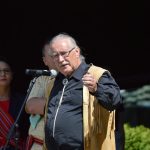Prince George Receives a Gift on Canada Day

“The Indian Act 2017” and the UNBC students who helped build it. Photos 250News
Prince George, B.C. – The community of Prince George has received a gift which, it is hoped, will provide the impetus for holding discussions leading to a reconciliation with First Nations.
During Canada Day celebrations here, the presentation of a unique birch bark messenger canoe with an interesting backdrop story was made. Marcel Labelle, who is from Matawa, Ontario, related that “I was contacted a few years ago by UNBC and Cercle des Canadiens Francais here to come and do a canoe project, funded by the Department of Canadian Heritage.”
“On my way up I harvested a root from each province, we harvested roots here in Prince George, we harvested gum here in Prince George. I had to bring the cedar and the bark from my home town, because I wasn’t sure what to expect here. But after I’d looked around, there’s all the materials used to build one of these canoes right here in this region.”
“I had students from UNBC build the canoe with me from scratch. The Cercle des Francophone got everything organized and I built it at Two Rivers Gallery. We were nine (people) involved in building the canoe. It took us six weeks to put it together and it floats. On the 5th (of July) we will be taking it to Cottonwood Island Park for an official paddle. We’ve tested it and it paddles beautifully.”
Labelle, whose spirit name in Algonquin is Mahigan, which means “Wolf”, says the canoe is made totally of traditional materials, “birch bark, spruce roots, cedar, ashes, bear fat and spruce gum. That’s it, nothing store-bought and all hand tools, no power tools.”
He says “I am Metis, actually Algonquin-French Canadian Metis. When my French ancestors came to Canada my Anishna Bay ancestors greeted them and that’s the gift they shared together. And things went well for a long time. Somewhere around Confederation, not so good.”
Canada my Anishna Bay ancestors greeted them and that’s the gift they shared together. And things went well for a long time. Somewhere around Confederation, not so good.”
“So we’re here today to re-introduce this gift and to invite Canadians to come and chat about this canoe. It has a name that was taken from the Constitution of Canada and that’s what we need to talk about. We need to talk about the Indian Act 2017. That’s its name, “The Indian Act 2017”.
Why that name? “If we’re celebrating Canada we have to celebrate all of it. Many of my indigenous friends are not celebrating, they’re protesting, but I chose to take part and to bring a message. It’s a messenger canoe. This is a beautiful country, can it be better? Yes it can be better. So that’s why we’re here, we can make it better.”
He says the task is to get the conversation going. He already spreads the message in schools, colleges and universities where, he says “there’s a new wave of people and a new way of thinking in Canada. They’re ready to sit and talk and that’s very important.”
“What are we going to do about the Indian Act? I’m not the one who’s going to decide but we’ve got to talk about it. I invite people at universities to read the Indian Act and they come back and most have the same opinion it’s the most racist document they’ve read. It’s part of our Constitution. Come on now.”
Labelle says the canoe won’t be “kept” anywhere. It will be in the care of Le Cercle des Canadiens Francais de Prince George, but he says it will float within the community, perhaps under the auspices of the City for a time, then another body and another, spurring that conversation.

Comments
Beautiful ! Thank you Marcel . Keeping Canada’s history alive is a noble ambition . Let’s hope someone will bring the York boat back to life . It was as equally responsible for the making of our country as the birch bark canoe and the Red river cart .
Very nice. Thumbs up to all the ones who worked on this project.
Comments for this article are closed.